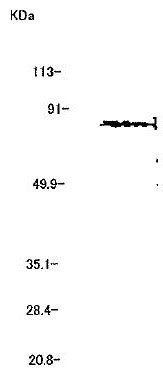IM33 Sigma-AldrichAnti-MMP-2 (Ab-3) Mouse mAb (42-5D11)
This Anti-MMP-2 (Ab-3) Mouse mAb (42-5D11) is validated for use in Frozen Sections, Immunoblotting, Paraffin Sections for the detection of MMP-2 (Ab-3).
More>> This Anti-MMP-2 (Ab-3) Mouse mAb (42-5D11) is validated for use in Frozen Sections, Immunoblotting, Paraffin Sections for the detection of MMP-2 (Ab-3). Less<<Sinónimos: Anti-72 kDa Gelatinase, Anti-Gelatinase A, Anti-Matrix Metalloproteinase 2
Productos recomendados
Descripción
| Replacement Information |
|---|
Tabla espec. clave
| Species Reactivity | Host | Antibody Type |
|---|---|---|
| B, H, M, R | M | Monoclonal Antibody |
Precios y disponibilidad (Precios sin impuestos)
| Número de referencia | Disponiblidad | Embalaje | Cant./Env. | Precio(Precios sin impuestos) | Cantidad | |
|---|---|---|---|---|---|---|
| IM33-100UG |
|
Ampolla de plást. | 100 μg |
|
— |
| Product Information | |
|---|---|
| Declaration | Manufactured by Daiichi Fine Chemical Co., Ltd. Not available for sale in Japan. |
| Form | Liquid |
| Formulation | In 100 mM sodium phosphate buffer, 0.1% BSA, pH 7.0 |
| Negative control | MMP-9 protein (Cat. Nos. PF024 or PF038) |
| Positive control | MMP-2 protein (Cat. Nos. PF023 or PF037) |
| Preservative | ≤0.1% sodium azide |
| Quality Level | MQ100 |
| Physicochemical Information |
|---|
| Dimensions |
|---|
| Materials Information |
|---|
| Toxicological Information |
|---|
| Safety Information according to GHS |
|---|
| Safety Information |
|---|
| Product Usage Statements |
|---|
| Packaging Information |
|---|
| Transport Information |
|---|
| Supplemental Information |
|---|
| Specifications |
|---|
| Global Trade Item Number | |
|---|---|
| Número de referencia | GTIN |
| IM33-100UG | 07790788053772 |
Documentation
Anti-MMP-2 (Ab-3) Mouse mAb (42-5D11) Ficha datos de seguridad (MSDS)
| Título |
|---|
Anti-MMP-2 (Ab-3) Mouse mAb (42-5D11) Certificados de análisis
| Cargo | Número de lote |
|---|---|
| IM33 |
Referencias bibliográficas
| Visión general referencias |
|---|
| Cottam, D. W. and Rees, R. C. 1993. Intl J. Oncol. 2, 861. Fujimoto, N., et al. 1993. Clinica Chimica Acta. 221, 91. Stetler-Stevenson, W. G., et al. 1993. FASEB J. 7, 1434. Woessner, J. F. 1991. FASEB J. 5, 2145. Liotta, L. A. and Stetler-Stevenson, W. G. 1990. in Seminars in Cancer Biology, ed. M. M. Gottesman. Vol. 1(2), 99. |
Folleto
| Cargo |
|---|
| Angiogenesis and Tumor Metastasis Brochure and Technical Guide |








